Although organic content plays a crucial role in any marketing strategy, PPC ads are still king when it comes to generating sales and leads for B2B businesses. But with dozens of social media platforms and even more PPC ad formats, how do you know which is right for your business?
When you’re unfamiliar with PPC ad formats, it’s easy to waste your time and marketing budget on ads that flop. The last thing you want is to waste time when you could be getting a stream of new leads from your ads.
If you know a winning PPC ad strategy could bring in new clients for your B2B business but you’re unsure where to begin, this guide will give you all you need to know to get started on the right foot.
The Types of PPC Ad Formats
There are so many different types of ads across different platforms, it can feel overwhelming knowing which PPC format is best for your business. Let’s take a look at the different types of PPC ad formats and the pros and cons of each.
Google AdWords Ad Formats
Text-Only Ads
If you’re just starting out, text-only ads are the most straightforward. It has one or two headlines, a URL, and one or two short descriptions.

Pros:
- Quick and easy to create (no need to find images)
- No special software needed and only basic knowledge of ads
Cons:
- Don’t perform as well as ads with visual elements
- Most Google Ads are text only so there is a lot of competition
Google Shopping Ads
If someone does a general search for a product, these ads show as a product photo, title, and pricing. Usually as a scroll bar across the top of the search, but they will appear differently depending on the device.
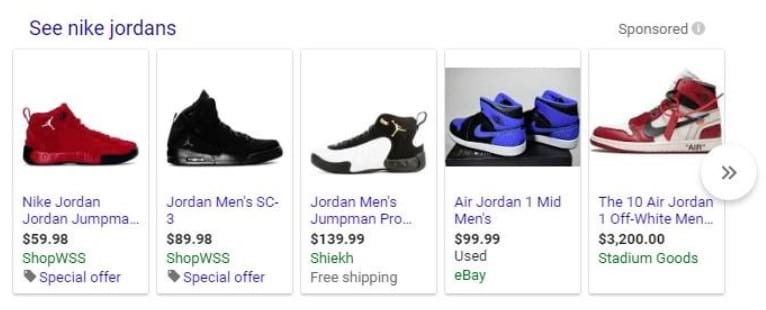
Pros:
- These Google users are primed to buy so more likely to spend money if they click your ad
- Large and visual, so get better engagement
- Can be automatically created using your data feed
Cons:
- Not all products will qualify for shopping ads
- Not available in all countries so international campaigns are difficult
Google Maps Ads
These are a great option for local businesses looking to stand out in their city or town. When a user searches for somewhere to eat or shop, these ads appear on their google map, showing where the location is.
Promoted pins are another type of ad used when users are browsing locations on their map app. These pop up even if the user hasn’t searched for anything, and goes on proximity.
Pros:
- Can increase awareness of your brand with local customers
- Good for restaurants, boutiques, cafes, etc. who rely on foot traffic
Cons:
- Only useful for local campaigns
- Minimal information is shown on the map app, relying on users to click to find out more
Call-Only Ads
These are mobile-specific ads that encourage users to call your business. They won’t show on laptops, only devices that are capable of making a call.
If a user clicks a call-only ad, they aren’t taken to your website but instead their phone will call the number immediately.
Pros:
- Easy to create with minimal information needed
- Good option for service-based businesses that want to schedule appointments or callouts.
Cons:
- Higher cost-per-click than text-only ads
- Not all businesses will benefit from customer calls
- Many users can be put off by being forced to call the business rather than visit a website
Image Ads
As the name suggests, these ads include visuals to showcase your brand or product. These can be static, HTML5, GIF, or Flash formats – giving you the option to create animated or interactive ads.
These will appear as banners on specific websites, rather than in a Google search.
Pros:
- Visual ads are much more noticeable
- Different sizes and formats to try out
- Easy to target your niche audience
Cons:
- Takes more time and effort to create compelling visuals
- People are so used to being bombarded with banner ads that they often get ignored
Video Ads
Video is becoming the most popular form of advertising with platforms like TikTok becoming more popular. A short but engaging video ad is memorable and can help your brand stand out online.
Video ads are usually shown on YouTube which has 2 billion monthly active users. Making this a great place to reach customers.
Pros:
- Convey more information than static ads
- Users must engage for at least a couple of seconds before skipping
- Good video ads have a high engagement rate
Cons:
- Time-consuming and expensive to make high-quality video ads
- Require specialized equipment and editing software
- Only have a short window to capture the user’s attention
Responsive Ads
These ads automatically adjust the size, format, and appearance to fit the space. For example, it might appear as a text-only ad on a small device, but an large banner image on larger devices.
This is a good option to make sure your ad appears in the best format with the most informative use of information, regardless of device.
Pros:
- Automatically optimize your ad for more conversions
- Better reach since it adjusts to different devices
- Saves you time creating multiple ad formats
Cons:
- Less control over your ad size and placement
- The largest ad type isn’t always the right option for larger devices
Facebook Ad Formats
Link Click Ads
These appear on the right column on desktops and the newsfeed on mobiles. They will include a link to an external website, a title, short description, and an image. The aim is to get users to click the link and visit your website which is then optimized for sales or conversions.

Pros:
- Easy to create
- When high-quality, can give good engagement
- Optimized for different newsfeeds (desktop, mobile, Instagram)
Cons:
- Depending on your niche, can have a high cost-per-click
- A lot of competition
Video Ads
Video ads are just another form of link click ads, but instead of static images, they have a video. These are becoming much more common as video continues to grow in popularity with users.

Pros:
- Supported across multiple platforms (Facebook feed, Instagram reels)
- Better engagement than static images
Cons:
- Time-consuming to create
- High cost-per-click
- Need specialized equipment and editing software
Boosted Page Posts
Facebook allows you to boost the reach of a Facebook post by “boosting” it. This means it will be shown to more people and gives you the option to create a target audience to help you target a niche.
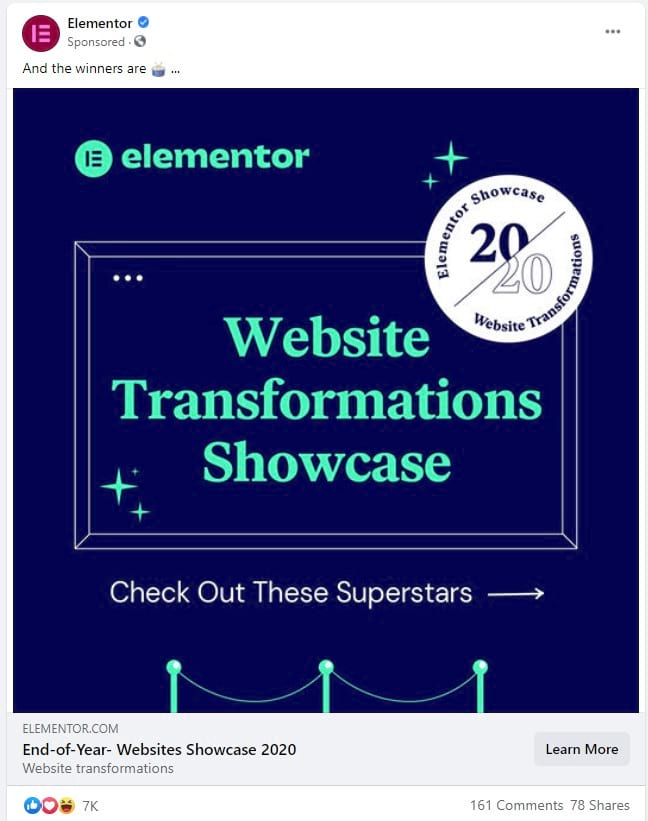
Pros:
- Very easy to do (once you have an audience set up, you can boost a post with one click)
- Helps you capitalize on any posts that are already doing well
Cons:
- If you don’t have an audience set up, Facebook will boost it to a general audience which is a waste of marketing budget
- If the post isn’t already doing very well, you’ll likely see little engagement
Multi-Product (Carousel Ads)
This is a good option for brands with multiple products for sale. The carousel allows you to add up to ten images or videos along with headlines and links to showcase your products.
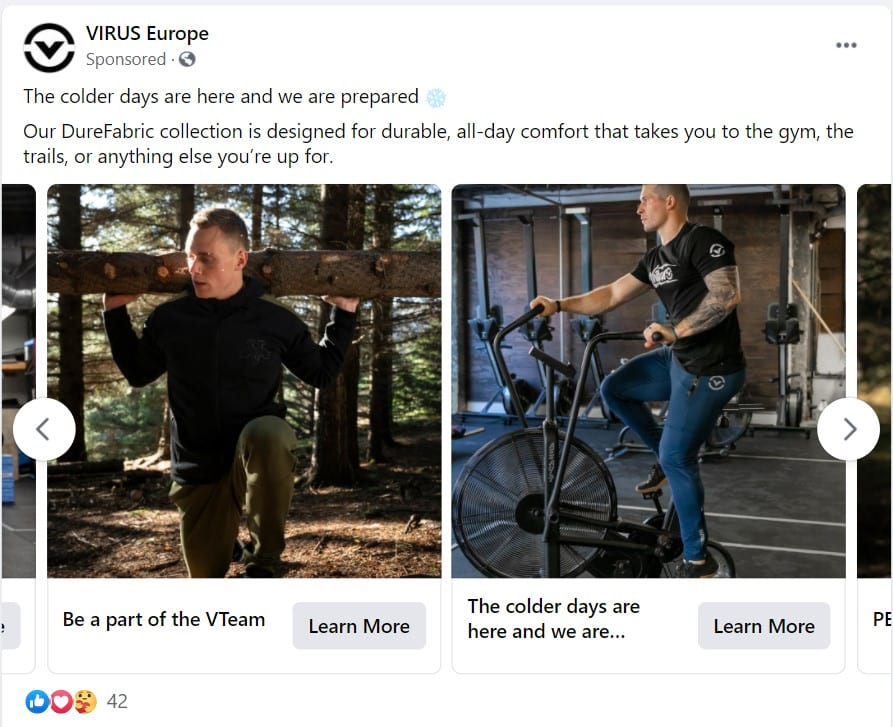
Pros:
- Gives insight into which products are most popular
- Helps you showcase a range of products all at once
Cons:
- Less useful for service-based businesses
- Takes longer to set up and optimize
Dynamic Product Ads (DPA)
Dynamic Product Ads target users based on their past actions. For example, if a user visits your website and views a product but doesn’t make a purchase, a DPA will promote that product on their feed to encourage them to come back and buy.
You’ll need a full product catalog on Facebook and a Facebook Pixel properly installed on your website for this to work. But it’s worth these steps as retargeting is an effective way to make sales.
Pros:
- Targets users who are already primed to make a purchase
- Automatic once you set up your catalog and pixel
Cons:
- Less useful for service-based businesses
- Less control over what ads users are seeing
LinkedIn Ad Formats
Sponsored Content
Sponsored ads appear in the LinkedIn newsfeed alongside regular content. They are like promoted posts since they are the just normal content you’d post to your company page including links, images, and content.
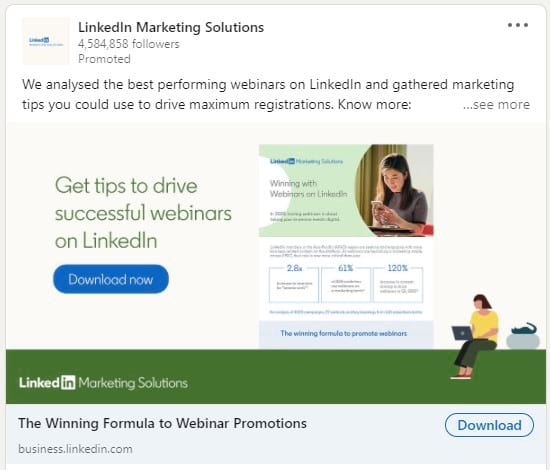
Sponsored content is best for:
- Raising awareness of events
- Generating leads with pre-filled lead gen forms
- Increasing traffic to your posts or company page
- Getting more followers
Sponsored InMail
This allows you to send personalized messages to your target audience. It only delivers to active LinkedIn members, so you won’t get bounce backs or abandoned messages like you do with regular email.
LinkedIn offers a responsive design so your CTA is clear and always visible no matter the device. And it offers A/B testing so you can run multiple messages to test what gets the best response.
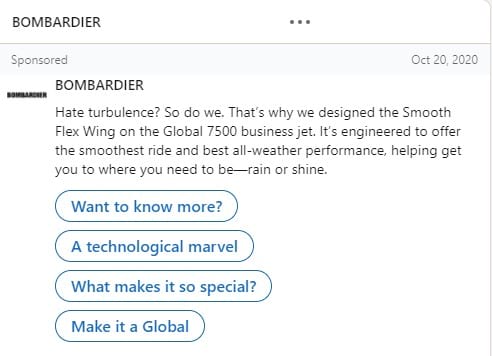
Sponsored InMail is best for:
- Getting more downloads of opt-ins
- Promoting webinars and special offers
- Generating warm B2B leads
Text Ads
This is LinkedIn’s version of pay-per-click (PPC) ad. They appear inline with the feed or on the side rail. You pay per click and can use LinkedIn’s analytics tools to target very specific audiences, which gives a good ROI.
Text ads on LinkedIn are usually more expensive than other platforms, but the ability to target specific audiences is also unmatched.
LinkedIn text ads are best for:
- Targeting ultra-specific B2B audiences
- Driving traffic to your website
- Attracting qualified job candidates
Twitter Ad Formats
Twitter ads are less common among B2B markets, but can be a good way to bring awareness to your brand. Here’s a quick breakdown:
Promoted Tweets
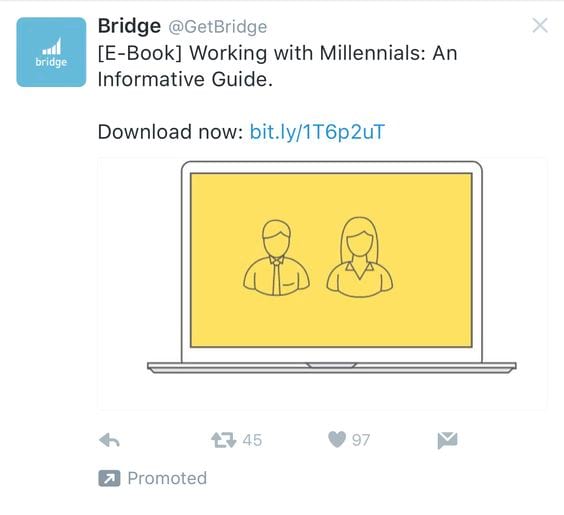
You can boost the visibility of any of your regular tweets just like Facebook post boosts. It’s best to only use this feature if you have a very popular tweet and a targeted audience to make sure you get quality engagement.
Promoted Videos
If you’ve created a quality promotional video of your brand, service, or product, you can promote it on Twitter using a promoted video campaign. This will get more eyes on your video to boost awareness.
Pre-roll videos
Pre-roll videos are played at the beginning of a video, just like YouTube ads. However, these are reserved for Twitter’s chosen content partners as they are high-ticket ad placements.
Website Cards
These help drive more traffic to your landing pages or website. Usually an eye-catching image or video, you can attach these to regular tweets to share with your audience, allowing users to click through.
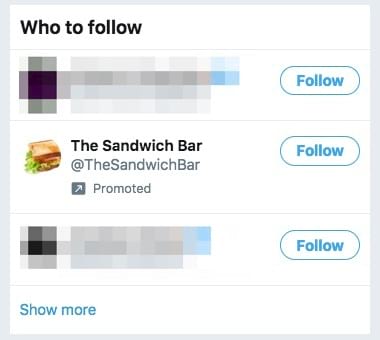
Instagram Ad Formats
Instagram ads are best for visual brands since it is a visual platform. If you decide to use Facebook ads, these are often shown to Instagram users where appropriate. But you can also optimize your ads specifically for Instagram.
Images
You can use a single image for your ad accompanied by a caption. This acts like a boosted Facebook post, being pushed to a targeted audience.
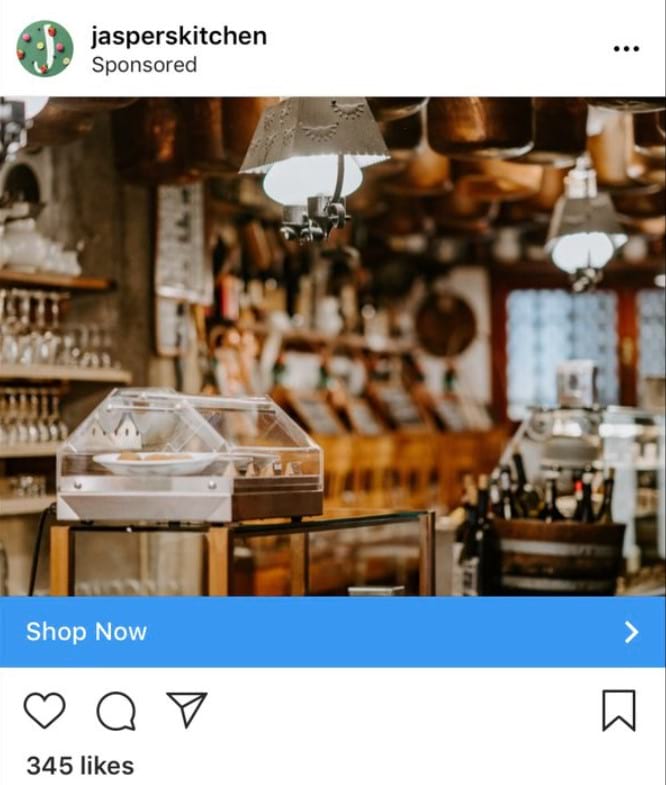
Videos
Now Instagram reels are becoming more and more popular, video ads are outperforming image ads. Video ads can appear in both the regular feed and reels of your targeted audience. Although these are usually more expensive than image ads, they do tend to perform better.
Carousel
Just like Facebook, carousel ads allow you to showcase multiple products in a single ad. These can appear on stories or the normal feed, and can help you narrow down which products are most popular with your audience.
Instagram Stories
Ads on stories are best when full-screen vertical images or videos. However, Instagram offers optimization to ensure your ads are the right ratio for the different places it could show up. Stories are the most engaging content on Instagram, so this is a great place to showcase products or promote your brand.
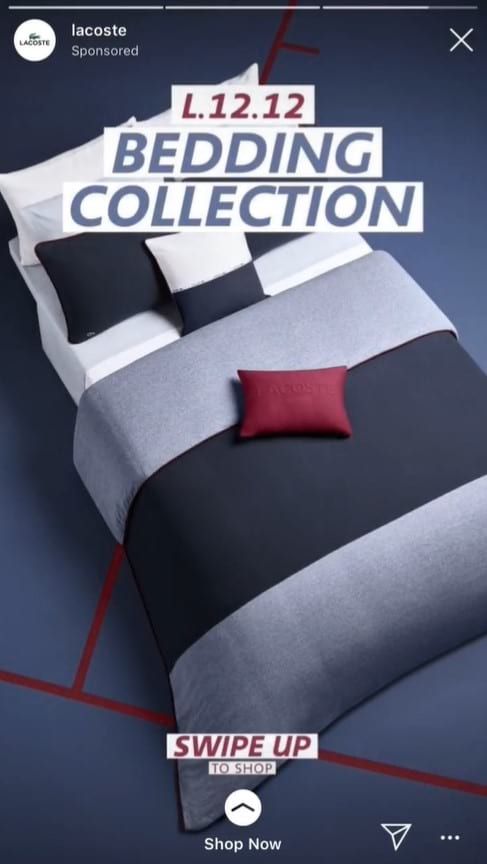
IGTV
If you have longer video ads, IGTV is the best place. This allows up to 15 seconds of video which gives you a better chance to capture your audience’s attention. Although remember they will have the option to skip, so it’s important to make a high-quality video with engaging content.
YouTube Ad Formats
Skippable video ads
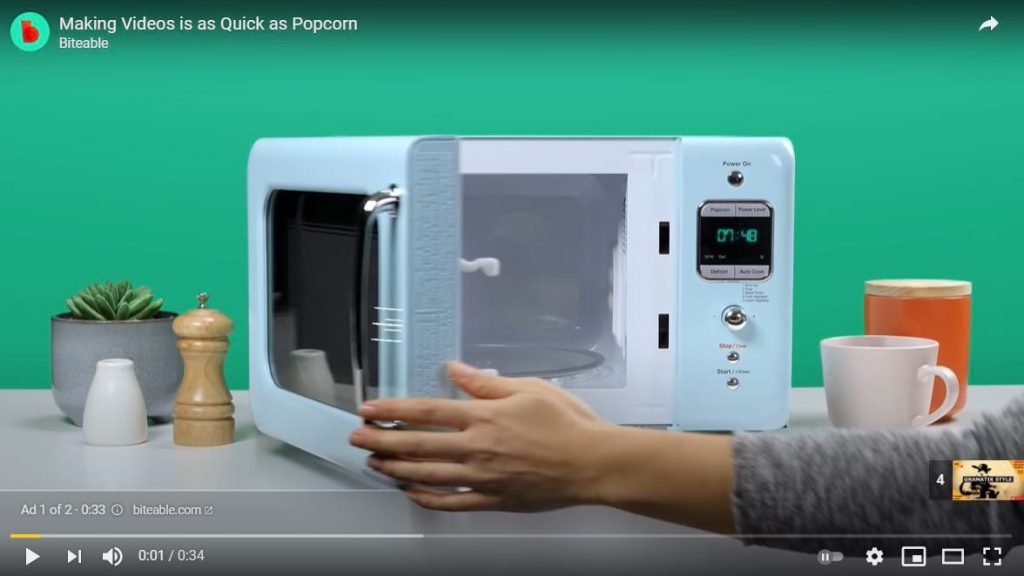
The ads that appear at the beginning of videos that users can skip after five seconds. These need to be extremely engaging to capture the user’s attention since these are usually skipped.
Non-skippable video ads
These cost more to place than skippable ads, but they also have better engagement since the user is forced to watch the entire ad. For best results, the ad needs to be professionally filmed and edited, and have a strong brand message and CTA.
Bumper ads
These are shorter non-skippable ads that play at the beginning of a video. These are played whether non-skippable ads are enabled or not. But since they’re shorter, they need to be hyper-specific with a strong message to catch the user’s attention.
Overlay ads

These are images or text that appear over the lower 20% of the video playing. Users will see a small X which allows them to remove the ad if they want to. These are only available on desktop which limits their reach, but they are usually viewed for longer, giving a better chance of engagement.
Which Type of PPC Ads Should I Choose?
There is no one type of PPC ad on any platform that performs best. In fact, the type of ad you choose will totally depend on your industry, niche, product or service, and aim.
If you’re aiming to promote a new product that is highly visual, then Instagram ads might be the best option.
However, if you’re a B2B looking to generate warm leads, LinkedIn ads are going to perform better.
Before investing in any type of PPC ads, make sure to figure out what your goals of the ad are, who your audience is, and what messaging will best speak to that audience.
Once you’ve figured out the best PPC ad format, you can move onto nailing down your PPC Campaign Management to get the best results.
Ready to Get Started With PPC Ads?
Now you have a better understanding of the PPC ad formats available, it’s time to jump into creating a strategic campaign.
Need help setting up or managing your PPC ads? Request a personalized demo today and see why bant.io is the best choice when it comes to managing your PPC campaigns.

